This set of Engineering Drawing Multiple Choice Questions & Answers (MCQs) focuses on “Multi-View Projections”.
1. In engineering drawings, the three-view multi-view drawing is standard. What are the collections of three-view drawings?
a) The top, front, and the left-side views
b) The front, bottom and the right-side views
c) The bottom, rare and the top views
d) The top, front and the right side views
View Answer
Explanation: For the complete descriptions of an object three-view of multi-view projections are required, they are the top, front and the right-side views.
2. Multi-view projections are the collection of orthogonal two-dimensional projections of a three-dimensional body.
a) True
b) False
View Answer
Explanation: In the engineering drawing, multi-view projections are the collection of 2-D drawings for a clear understanding of the dimensions of the 3-D object.
3. Which of the following are the appropriate views of the given object in a third angle projection?
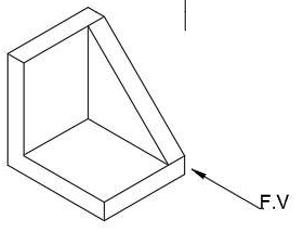
a) 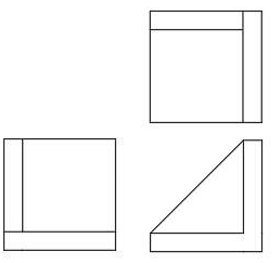
b) 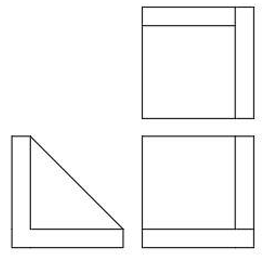
c) 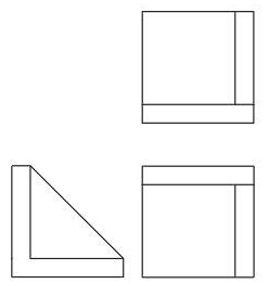
d) 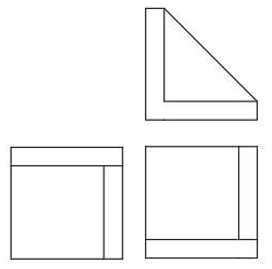
View Answer
Explanation: In third-angle projections, we have object positioned in third-quadrant between two principal planes. Here, the front view, top view, and the left-hand side view are enough to require the object completely.
4. In multi-view projections, primary views are plans, sections, and elevations.
a) False
b) True
View Answer
Explanation: In multi-view projections, plan, elevation, and section are the other names of front, top and side views. These are viewed in a parallel direction to coordinate axes.
5. If the object is placed in the first quadrant, the projected view results in the ____
a) First-angle projection
b) Second-angle projection
c) Third-angle projection
d) Fourth-angle projection
View Answer
Explanation: First-angle projection is one of the standard projection, where the projection is in the same direction of the ray of sight. It is considered as the object is placed in the first quadrant and two parallel planes are used to get the projections.
6. In third angle projection, the projections of the object are in the ______ direction of the ray of sight.
a) Same
b) Opposite
c) Upward
d) Downward
View Answer
Explanation: In the third angle projection, the projection plane will be in the middle of the object and the observer. Hence the projection lines direction will be opposite to the direction of the ray of sight.
7. In the first angle projection, what is the sequence of the following list?
P) Observer
Q) Object
R) Plane
a) P-Q-R
b) Q-P-R
c) R-P-Q
d) P-R-Q
View Answer
Explanation: In the first angle projection, an object comes in between the observer and the plane. In first angle projections, the direction of projection lines is the same as the direction of the ray of sight.
8. Which of the following are the appropriate views of the given object in a first angle projection?

a) 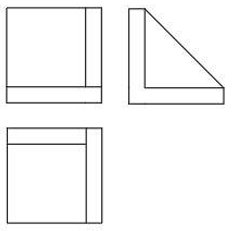
b) 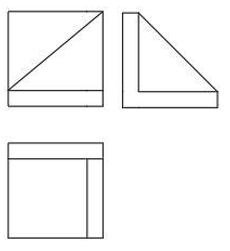
c) 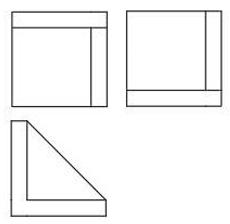
d) 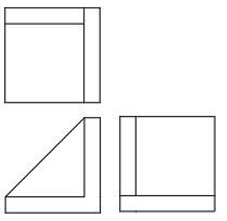
View Answer
Explanation: In first-angle projections, we have object positioned in first-quadrant between two principal planes. Here, the front view, top view, and the left-hand side view are enough to require the object completely.
9. In third angle projection, what is the sequence of the following list?
P) Observer
Q) Object
R) Plane
a) P-Q-R
b) Q-P-R
c) R-P-Q
d) P-R-Q
View Answer
Explanation: In the third angle projection, a plane comes in between the observer and the object. In third-angle projections, the direction of projection lines is opposite to the direction ray of sight.
10. When a portion of the drawing is enlarged for more accurate reading of the drawings, it is called ______
a) Half view
b) Partial view
c) Detailed view
d) Partial view
View Answer
Explanation: In detailed drawings, a portion of drawings which are small, are enlarged to describe the details completely. Here standard projection view is followed.
11. Which view is represented by the lower case letters of the corners with single prime?
a) Top view
b) Side view
c) Front view
d) Auxiliary view
View Answer
Explanation: Top view is represented by the lower case letters of the corners only.
Side view is represented by the lower case letters of the corners with double prime.
Front view is represented by the lower case letters of the corners with single prime.
12. What dimensions does top view represents?
a) Length and width
b) Width and height
c) Length and height
d) Length and thickness
View Answer
Explanation: It can be observed that the front view represents the dimensions of length and height of the object, while the top view represents the dimensions of length and width of the object. Since the length dimensions are common for both these views, these views are laid one below the other.
13. The sketch corresponding to the frontal surface is called _____
a) Side view
b) Top view
c) Auxiliary view
d) Front view
View Answer
Explanation: Front view tells about the length and the height dimensions of the object. The sketch corresponding to the top surface is called top view and side appearances bring the height and the width and can be obtained from the front and top view.
14. Typical examples that show the systematic development of multiple views of various features such as cut-outs, slope, slots, arcs, holes and their combinations are demonstrated with logical reasoning and common observations.
a) True
b) False
View Answer
Explanation: Freehand sketching of the multiple views of a basic 3-dimensional rectangular block was discussed when many features in the form of cut-outs, slots, and holes were made on it. The views were also explained when the cuts were resulting in sloping or inclined edges or cut-outs made in the form of circular arcs, single, or multiple in nature.
Sanfoundry Global Education & Learning Series – Engineering Drawing.
To practice all areas of Engineering Drawing, here is complete set of 1000+ Multiple Choice Questions and Answers.
If you find a mistake in question / option / answer, kindly take a screenshot and email to [email protected]
